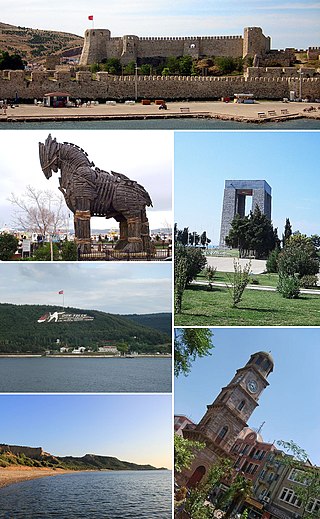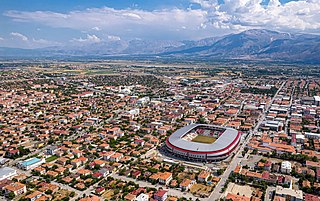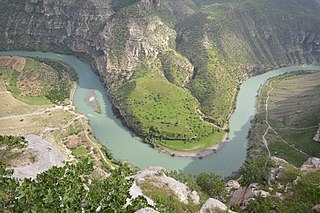
Diyarbakır Province is a province and metropolitan municipality in southeastern Turkey. Its area is 15,101 km2, and its population is 1,804,880 (2022). The provincial capital is the city of Diyarbakır. The Kurdish majority province is part of Turkish Kurdistan.

Çanakkale Province is a province of Turkey, located in the northwestern part of the country. It takes its name from the city of Çanakkale. Its area is 9,817 km2, and its population is 559,383 (2022).

Edirne Province is a Turkish province located in East Thrace. Part of European Turkey, it is one of only three provinces located entirely within continental Europe. Its area is 6,145 km2, and its population is 414,714 (2022). Edirne Province is bordered by Tekirdağ Province and Kırklareli Province to the east, and the Gallipoli peninsula of Çanakkale Province to the south-east. It shares international borders with Bulgaria to the north and Greece to the west. Edirne is the capital of the province, and the largest city. It is the only province of Turkey that borders Greece.

Erzurum Province is a province and metropolitan municipality in the Eastern Anatolia Region of Turkey. Its area is 25,006 km2, and its population is 749,754 (2022). The capital of the province is the city of Erzurum. It’s the fourth largest province in all of Turkey. It is bordered by the provinces of Kars and Ağrı to the east, Muş and Bingöl to the south, Erzincan and Bayburt to the west, Rize and Artvin to the north and Ardahan to the northeast. The governor of the province is Mustafa Çiftçi, appointed in August 2023. The province has a Turkish majority.

Trabzon Province is a province and metropolitan municipality of Turkey on the Black Sea coast. Its area is 4,628 km2, and its population is 818,023 (2022). Located in a strategically important region, Trabzon is one of the oldest trade port cities in Anatolia. Neighbouring provinces are Giresun to the west, Gümüşhane to the southwest, Bayburt to the southeast and Rize to the east. Aziz Yıldırım was appointed Governor of the province in August 2023. The capital of the province is Trabzon.

Elazığ Province is a province of Turkey with its seat in the city of Elazığ. Its area is 9,383 km2, and its population is 591,497 (2022). The population of the province was 569,616 in 2000 and 498,225 in 1990. The province is considered part of Turkish Kurdistan and has a Kurdish majority with a significant Turkish minority.

The Ağrı Province is a province in eastern Turkey, bordering Iran to the east, Kars to the north, Erzurum to the northwest, Muş and Bitlis to the southwest, Van to the south, and Iğdır to the northeast. Its area is 11,099 km2, and its population is 510,626 (2022). The provincial capital is Ağrı, situated on a 1,650 metres (5,410 ft) high plateau. Doğubayazıt was the capital of the province until 1946. The current governor is Mustafa Koç.

Hakkâri Province, is a province in the southeast of Turkey. The administrative centre is the city of Hakkâri. Its area is 7,095 km2, and its population is 287,625 (2023). The current Governor is Ali Çelik. The province encompasses 8 municipalities, 140 villages and 313 hamlets.

Kırklareli Province is a province in northwestern Turkey on the west coast of the Black Sea. The province neighbours Bulgaria to the north along a 180-kilometre (110 mi) long border. It borders the province of Edirne to the west and the province of Tekirdağ to the south and province of Istanbul to the southeast. Kırklareli is the capital city of the province. Its area is 6,459 km2, and its population is 369,347 (2022). The province's and its central city's name means "the land of the forties" in Turkish and it may refer either to the forty Ottoman ghazis sent by the sultan Murad I to conquer the city for the Ottoman Empire in the 14th century or to the forty churches reported to be situated in the region before the Ottoman conquest, as attested by the former name of Kırklareli. There is a memorial on a hilltop in Kırklareli city, called "Kırklar Anıtı" to honor the Ottoman conquerors. The province is bisected by the Yıldız (Istranca) mountain range. The north and northeastern parts of the province are among the least populated and under developed parts of Turkey. The districts to the south and west are more populated because the land is better suited for agriculture and industrial development. The north and eastern parts of the province are dominated by forests. Therefore, forestry is an important means of living in these areas. Fishing is done along the Black Sea coast.

Bingöl Province is a province of Turkey. The province was known as Çapakçur Province before 1945 when it was renamed as Bingöl Province. Its area is 8,003 km2, and its population is 282,556 (2022). The province encompasses 11 municipalities, 325 villages and 693 hamlets.

Bitlis Province is a province of eastern Turkey, located to the west of Lake Van. It takes its name from the central city, Bitlis. Its area is 8,294 km2, and its population is 353,988 (2022). The province is considered part of Western Armenia by Armenians. The province is considered part of Turkish Kurdistan and has a Kurdish majority. The current Governor of the province is Erol Karaömeroğlu.

Erzincan Province is a province in the Eastern Anatolia Region of Turkey. In Turkey, its capital is also called Erzincan. Its area is 11,815 km2, and its population is 239,223 (2022).

Gümüşhane Province is a province in northern Turkey, bordering Bayburt to the east, Trabzon to the north, Giresun and Erzincan to the west. Its area is 6,668 km2, and its population is 144,544 (2022). The population was 186,953 in 2000. Gümüşhane is the capital city of the province. The name Gümüşhane means silver house. The city has a rich mining history and was the source of exports for Trabzon. The current Governor is Alper Tanrısever, appointed in August 2023.

Siirt Province, is a province of Turkey, located in the southeast. The province borders Bitlis to the north, Batman to the west, Mardin to the southwest, Şırnak to the south, and Van to the east. Its area is 5,717 km2, and its population is 331,311 (2022). Its capital is Siirt. It encompasses 12 municipalities, 280 villages and 214 hamlets.

The Dersim massacre, also known as Dersim genocide, was carried out by the Turkish military over the course of three operations in the Dersim Province against Kurdish Alevi rebels and civilians in 1937 and 1938. Although most Kurds in Dersim remained in their home villages, thousands were killed and many others were expelled to other parts of Turkey. Twenty tons of “Chloracetophenon, Iperit and so on” were ordered and used in the massacre.

Şırnak Province is a province in Turkey in the Southeastern Anatolia Region. Şırnak Province was created in 1990, with areas that were formerly part of the Siirt, Hakkâri and Mardin Provinces. It borders both Kurdistan Region of Iraq and Syria. The current Governor of the province is Cevdet Atay.

Tunceli Province, formerly Dersim Province, is a province in the Eastern Anatolia Region of Turkey. Its central city is Tunceli. The province is considered part of Turkish Kurdistan and has a Kurdish majority. Moreover, it is the only province in Turkey with an Alevi majority. The province has eight municipalities, 366 villages and 1,087 hamlets.
The First Inspectorate-General refers to a former regional administrative area in Turkey. The First Inspectorate-General span over the provinces Hakkâri, Siirt, Şırnak, Mardin, Şanlıurfa, Bitlis, Elazığ and Van.
The Fourth Inspectorate-General refers to a regional administrative subdivision in the Dersim region.
The Second Inspectorate-General refers to a Turkish regional administrative subdivision comprising the provinces Edirne, Çanakkale, Kırklareli and Tekirdağ.